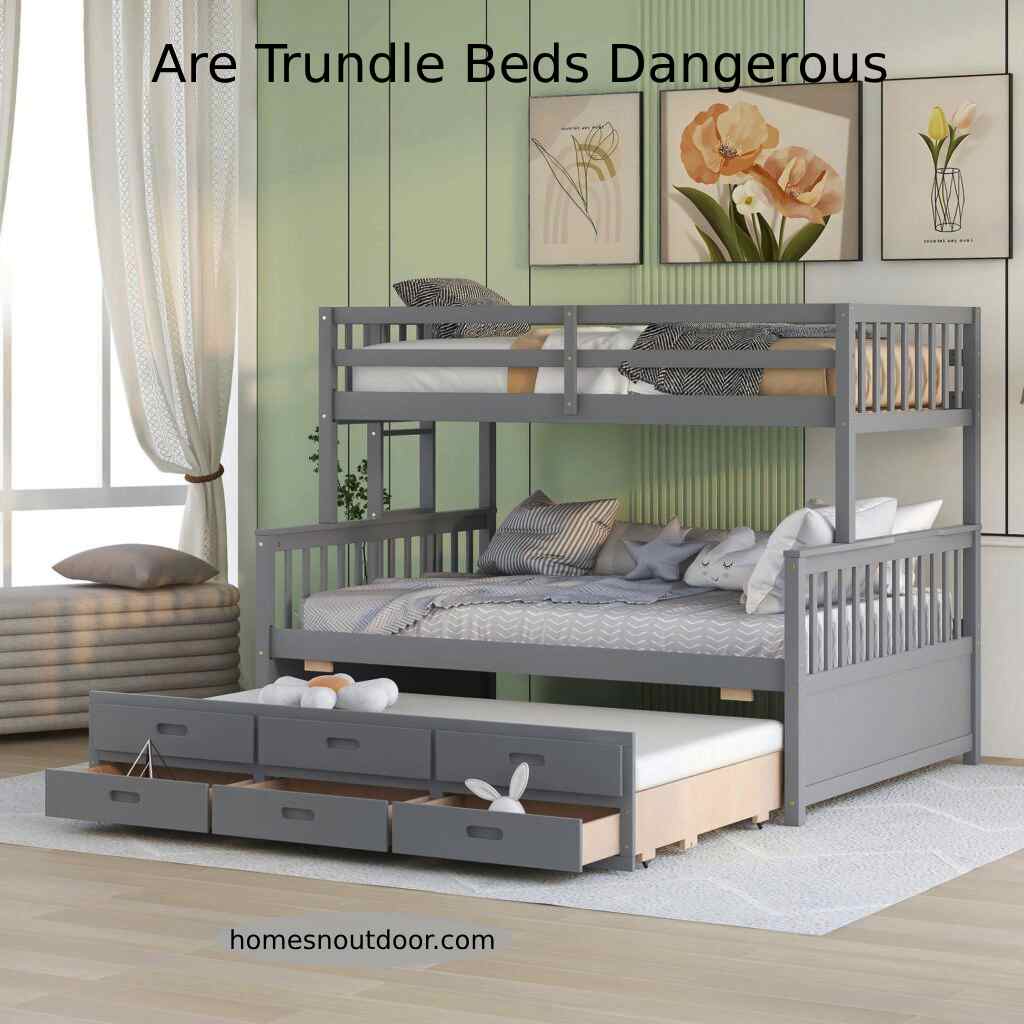Trundle beds are not inherently dangerous, but safety depends on proper use and design. Adequate assembly and age-appropriate use can minimize risks.
A trundle bed offers a convenient space-saving solution for sleeping arrangements, particularly in rooms where floor space is at a premium, such as children’s bedrooms or guest rooms. Designed to tuck neatly under a main bed frame, trundle beds slide out for use and can be easily stored away, making them an ideal choice for occasional use.
Safety concerns usually involve ensuring the stability of the upper bed and the smooth operation of the trundle mechanism to prevent injuries. Proper maintenance and adherence to the manufacturer’s guidelines can ensure that trundle beds are a safe addition to any home. It’s essential to select a bed with sturdy construction and to follow all provided instructions for assembly and weight limits to ensure the safety and longevity of your trundle bed.


Introduction To Trundle Beds
Trundle beds are a unique type of bed designed to maximize space and offer a convenient sleeping solution. Characterized by a second bed hidden underneath, these space-savers are easily accessible and can be pulled out or tucked away as needed. There are two primary types: drawer trundles, which function like large drawers, and pop-up trundles, which elevate to the height of the main bed.
Due to their versatile nature, trundle beds have become increasingly popular, especially in guest rooms, children’s bedrooms, and small living spaces. They offer a practical solution for overnight guests or for siblings sharing a room, without occupying the floor space a regular bed would when not in use.
When compared with standard beds, trundles are more compact and multifunctional. However, it’s important to consider aspects such as bed height and accessibility for the user, making sure the design and quality prevent any potential hazards.


Safety Concerns Of Trundle Beds
Trundle beds, known for their space-saving design, pose several risks that need to be taken into account. Parents should be mindful of the potential for accidents, particularly with children who may be tempted to treat the pull-out component as a toy. Entanglement in the mechanism or gaps can lead to injuries.
Moreover, adults are not exempt from incidents involving trundle beds. Incorrect usage or failure to secure the bed properly can result in collapse or instability, leading to falls or entrapment. Recognizing these risks is critical for ensuring safety.
Reported incidents have led to increased scrutiny regarding safety standards. It is paramount to check that the trundle bed adheres to the relevant regulations and is free from manufacturing defects before purchase. Consumers should seek out models that feature safety certifications and should always review the manufacturer’s instructions to minimize hazards.
Mitigating Risks
Trundle beds can be a space-saving and convenient sleeping solution, but it is essential to prioritize safety. Adhering to best practices for safe use, such as ensuring the trundle bed’s mattress is the correct size and using guardrails, can significantly reduce risks. It’s crucial that the structure is robust and does not have sharp edges that could potentially cause injury.
When selecting a trundle bed, one must pay attention to important safety features, like sturdy locks that keep the trundle bed in place when it’s either rolled out or stored away. Always choose beds with certifications that they meet safety standards. Reliable locking mechanisms and breathable materials also contribute to a safer sleep environment.
Maintenance and regular inspections play a pivotal role in preventing accidents. Check for signs of wear and tear, and address any structural problems immediately. Broken slats or a sagging foundation can pose a threat, making consistent upkeep non-negotiable for ensuring longevity and safety.
| Age Group | Safe Sleep Guidelines |
|---|---|
| Under 6 Years Old | Not recommended due to the risk of entrapment and falls. |
| 6 Years and Above | Ensure the presence of guardrails, limit the top bunk usage to one person, and train children to use ladders safely. |
Clear guidelines for safe sleep — especially age considerations — are essential. Typically, children under the age of six should not sleep in the top bunk of a trundle bed due to heightened risks of falls and entrapment. For children older than six, educating them on safe bed usage is as crucial as the bed’s design in preventing accidents.


Frequently Asked Questions On Are Trundle Beds Dangerous
Is Trundle Bed Safe?
Trundle beds are generally safe when used correctly and with a quality frame and mattress. Ensure safety rails and weight limits are respected, especially for children. Regular maintenance is also key to safety.
Do Trundle Beds Break Easily?
Trundle beds are generally durable but can break with improper use or poor construction. Ensure you choose a high-quality model and follow weight guidelines for longevity.
Can You Sleep On A Trundle Bed?
Yes, you can sleep on a trundle bed. These beds are designed to provide a convenient, space-saving sleep solution, ideal for occasional use.
How Much Weight Can A Trundle Bed Hold?
A trundle bed typically supports a weight limit of 250 pounds. Always check the manufacturer’s specifications for the exact weight capacity.
Conclusion
Safety concerns about trundle beds can stir worry, but knowing the facts eases minds. Proper use and regular maintenance typically prevent accidents. For families needing space-saving solutions, a trundle bed is a smart, functional choice. Embrace its convenience with confidence, while staying vigilant to ensure a safe sleeping environment.
Choose wisely, sleep soundly.

